In the World of SEO, Keywords play a crucial role to rank your website on search engines and also help to make SEO campaigns successful.
There are a few different types of keywords out there, But the ultimate goal of this article is to make you clearly understand the difference between short tail and long tail keywords.
It’s essential to know which keywords your audience is typing in the search to find your product or service so that you can target those keywords to rank at top of Google SERP and drive traffic to the site.
This guide will give you a complete overview of both keywords with examples, and also you will learn how to find keywords, that your target audience type on Google related to your business or website.
So, without wasting a minute, Let’s dive into it.
What are SEO keywords?
SEO keywords are words or phrases people use to search on search engines like Google to find information for their problems.
SEO professionals or marketers use keywords, and it is not related to users who are searching for a particular solution.
People directly type queries on Google without thinking about what particular words need to type, it’s your responsibility to find what keywords they are typing, so you can target them according to the product or services you offer.
So, it would be best if you choose the right keywords, which is the first important thing before going into any other SEO process.
And, knowing keywords and user search intent is necessary to target your audience, and also, it’s a waste of time if you choose the wrong keywords for optimization.
Read about : why is keyword research important here!
What are Short tail keywords?
Short-tail keywords are known as head terms, generic, or seed keywords. These keywords come under length-based category type of keywords.
Short-tail keywords are general queries, done by people that cover broad topics, and these keywords will have high search volume than long-tail keywords.
These short tail keywords usually contain 1-2 words with broad terms but are not specific about a particular topic. And being generic keywords, this keyword has higher competition to rank on Google.
Because they are not more specific, so they have a low conversion rate compared to long-tail keywords.
Ex: weight loss
What are Long tail Keywords?
Long tail keywords are those with the most extended search terms and are targeted to a specific topic or audience. And this keyword also comes under the length-based category type of keywords.
This Long tail keyword usually contains 3-4 plus words with a focus on a specific topic. And being the long search term, this keyword will have low search volume and low competition to rank on Google.
And, because they are more specific targeted keywords, they have higher conversion rates than short-tail keywords.
Ex: diet plan for weight loss for female
Difference between Short tail and long tail keywords with Examples?
The difference between short tail and long tail keywords is that long-tail keywords are more specific and have low search volume, low competition, and higher conversion rates.
At the same time, short-tail keywords are broad terms that are less specific and have high search volume, higher competition, and low conversion rates.
Let me give you clarity with some example
Short tail keywords examples
As I said, short tail keywords are 1-2 word phrases. Let’s take an above example of a short tail keyword as “weight loss”.
When I searched for the keyword “weight loss” in the keyword research tool, I got the overview of the keyword with search volume and Keyword Difficulty.
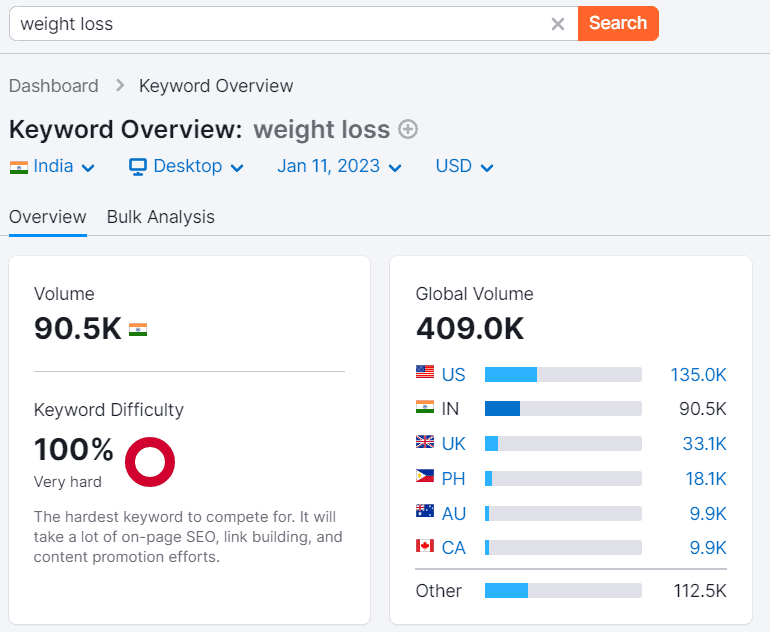
The above screenshot shows that the “weight loss” keyword has a huge search volume of 90500 in India. It means 90 thousand plus people are searching every month on Google by typing this keyword.
And not only that, you can see the keyword difficulty of the short tail keyword, it is 100% and shows very hard to rank on search engines like Google.
It doesn’t mean that, if you have a high search volume, you need to target that keyword, but it is not like that, you need to understand the user intent behind the keyword.
Here, from the keyword “weight loss”, you cannot understand the exact user intent. The user might be searching for any weight loss nutrition, diet plan, or exercise to lose weight. There is no specific intent for us to understand, to produce relevancy and quality content on that keyword.
So when you target short tail keywords, which have a huge search volume, it is tough to write content and challenge to rank on Google and there will be a low conversion rate too.
Long Tail Keywords Examples
Here, long tail keywords contain 3-4 plus words in a search query. Same Let’s take the above example of long tail keywords as “diet plan for weight loss for female”.
Again, when I searched for the keyword on the Keyword research tool. I got the overview of the keyword with search volume and keyword difficulty.
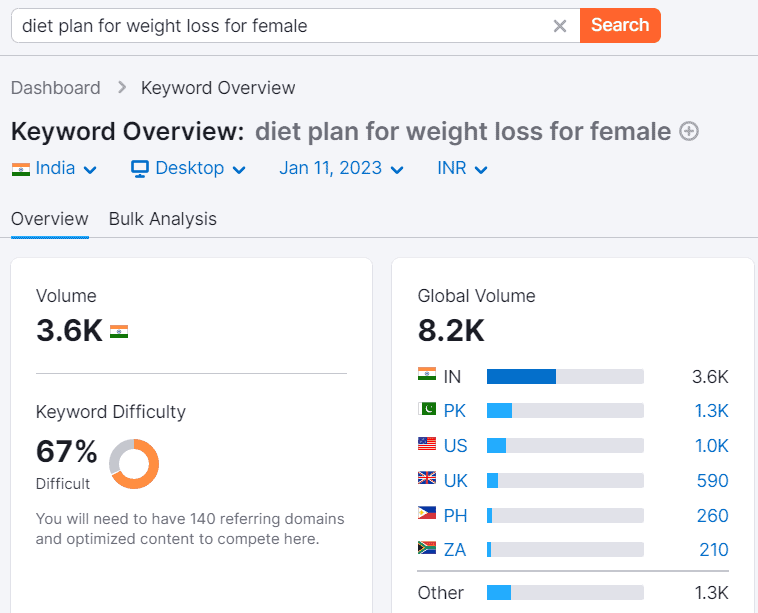
And, from the above screenshot, you can see that “diet plan for weight loss for female” has a low search volume of 3600 and a low keyword difficulty of 67% compared to the short tail keyword.
Here, from the above keyword, you can easily understand the exact user intent of what the user is searching for, and we got clarity that the user is searching for a diet plan for female to lose weight.
By Knowing the keyword’s specific user intent, you can produce relevant and quality content to solve the user problem.
So when you target long tail keywords, having less specific search volume and Low Keyword difficulty, you can rank on Google easily and there will be a high conversion rate for the product or service you offer.
And to give more clarity on short tail and long tail keywords, you can refer to the below image.
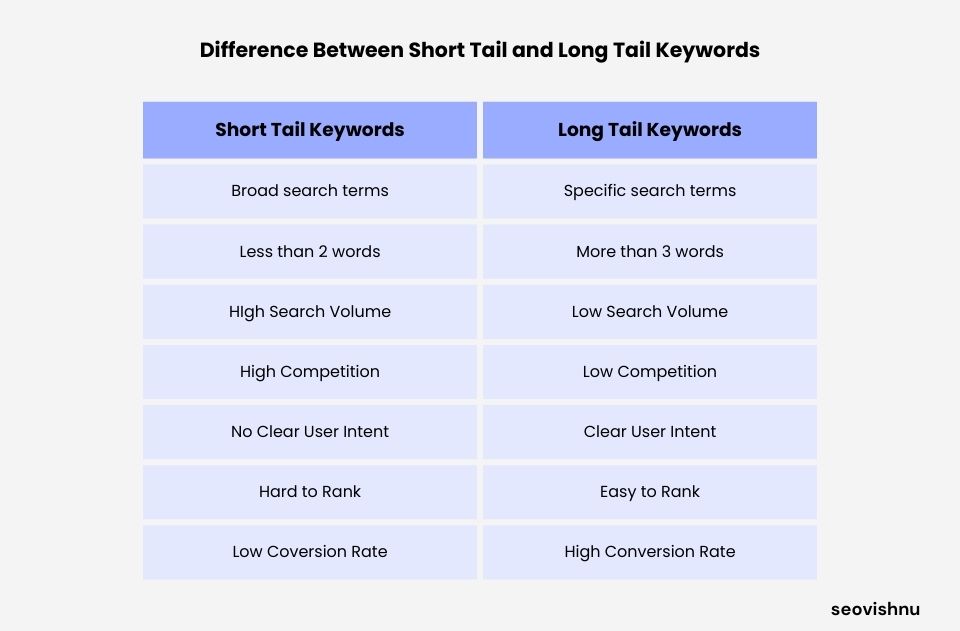
How To Find Short-tail keywords and Long-tail keywords
The process of finding keywords that your target audience is typing in the search box of Google is called keyword research.
And Keyword research is essential to know what your audience is typing on Google to find the related products or services you offer.
You can easily find short tail keywords by just brainstorming ideas. Think about the product or service you are offering and write down the keywords you would have searched for online.
For example, Let’s say someone is searching for weight loss, And some of the keywords people type on search are weight loss, lose weight, weight loss tips, weight loss workout, etc. These can be short-tail keywords.
If you want to go some more specific, the keywords will be such as weight loss tips at home, weight loss drinks at home, etc. These can be long-tail keywords.
So, here we can find long tail keywords by using head terms and we can efficiently target them and rank on Google due to low competition.
And, Below are the 5 ways to find keyword ideas.
Google Autocomplete
The first place to find keywords related to your industry is Google Autocomplete. It is the place where you can get suggestions from Google as shown below.

when you type a short tail keyword, google gives you original suggestions on what people are searching for on the particular keyword.
Related searches
Related searches, are a place on Google SERP below the organic search results, where you can find different keywords related to the keyword you typed in the search box.
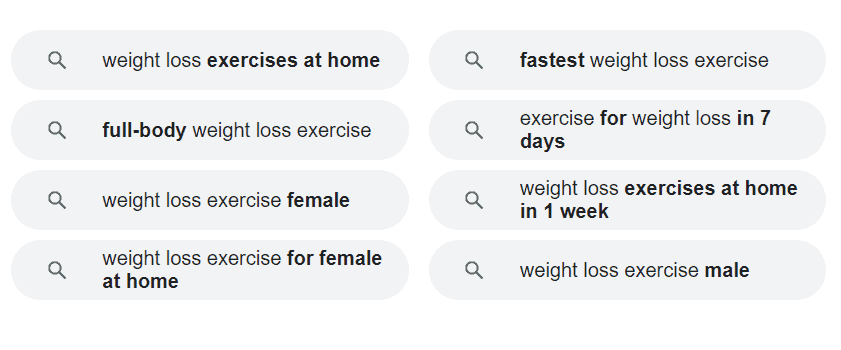
From the above image, you can see eight keywords, where people are also looking for related searches on weight loss.
You can add this list of related search keywords to your keyword list.
Google Keyword Planner
Google keyword planner is a free Google tool that helps you to find plenty of keyword ideas. You can also know the search volume range, happening on a particular keyword every month.
Steps to do keyword research on keyword planner
- Search Google keyword planner on Google.
- Click on 1st result shown as a Google keyword planner.
- Sign in to google keyword planner.
- Click on discover new keywords
- Enter your keyword and click on get results.
After clicking on get results, the Google keyword planner will give you different types of keywords as shown below.
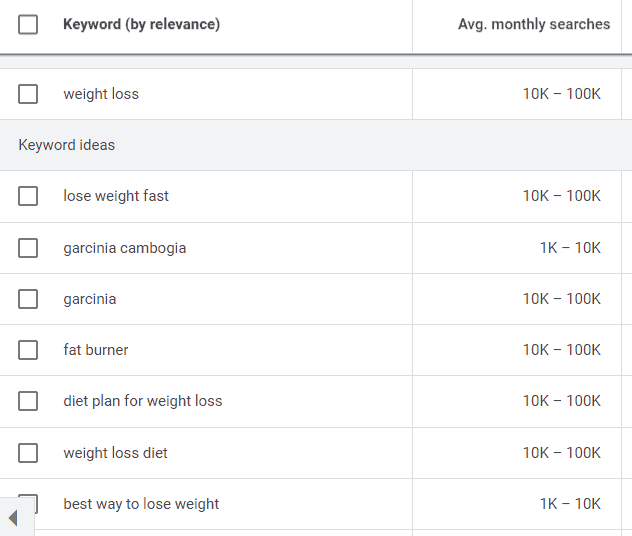
you can add the above keywords to your keyword research sheet or list.
SEMrush (Paid Tool)
SEMrush is a paid tool that helps you to find keywords ideas easily. Using this tool, you can also find different metrics for keywords, such as search volume, Keyword difficulty, and Cost Per Click (CPC) which you can add to your keywords list.
This tool generates an overview of keyword ideas and helps you find competitors’ keywords, and also helps to find for which keywords your competitor ranks.
So by knowing what your competitors ranking for, you can easily target those keywords to outrank them.
As you have seen above, I have added images of long-tail keywords and short-tail keywords examples by using the SEMrush tool.
And below here is the dashboard of SEMrush to give some idea about it.
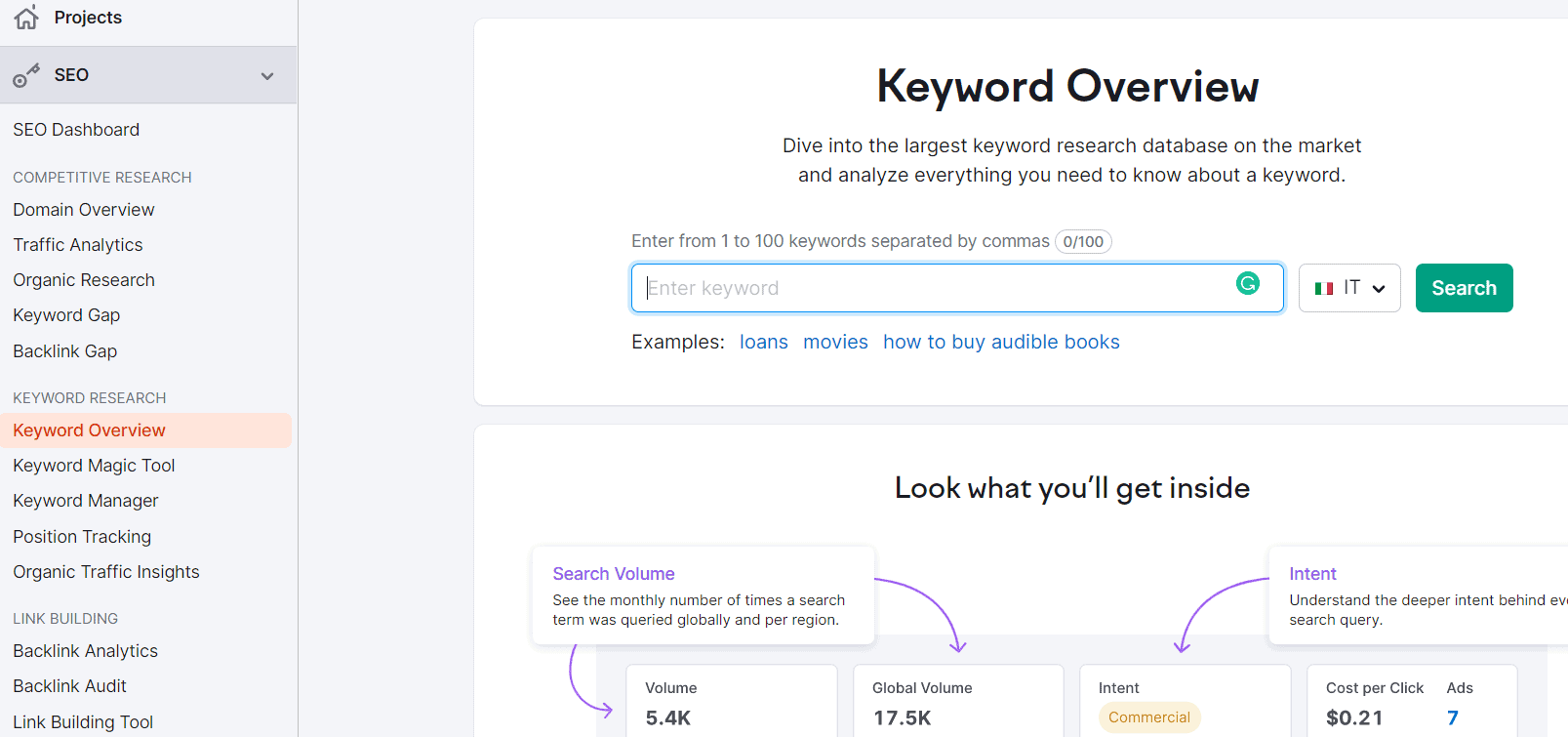
If you want to explore the tool, you can start with a 7-day free trial by signing up.
Ubersuggest (Freemium Tool)
Ubersuggest is a Freemium tool by Neil Patel that gives you three free searches daily to generate keyword ideas.
Put the keyword in the tool, that runs and gives you an overview of the keyword, as shown below.
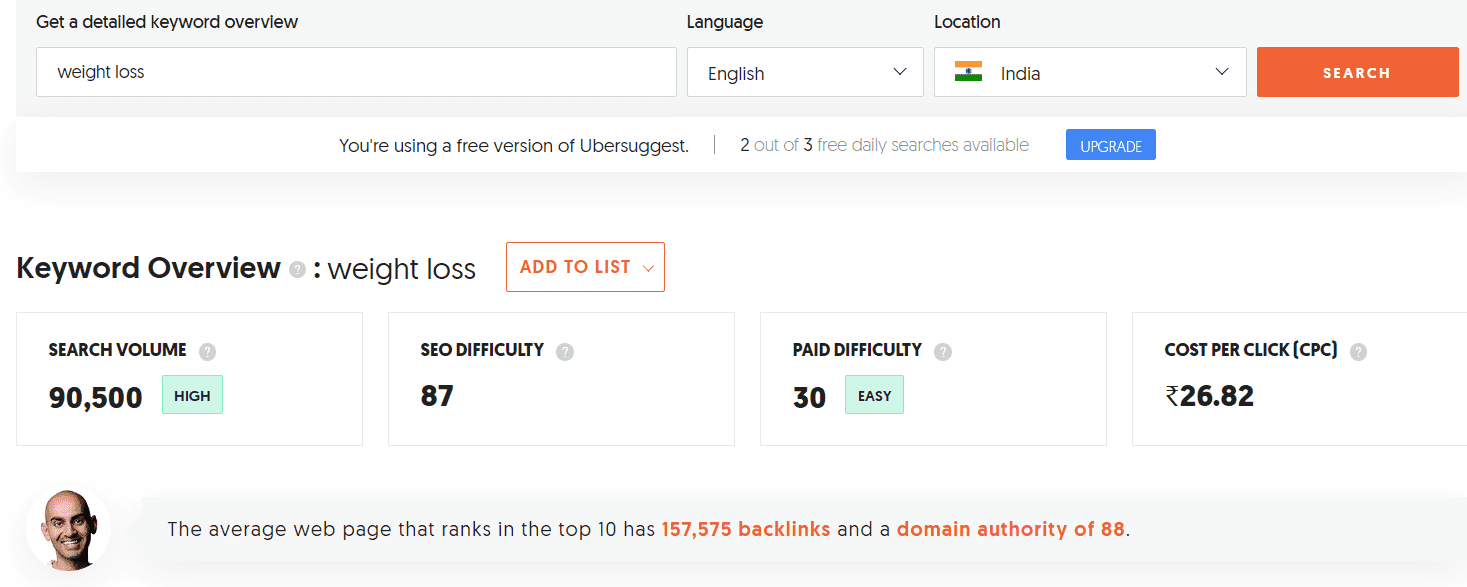
And it also gives you plenty of different short tail and long tail keywords ideas when you scroll down, as shown below.
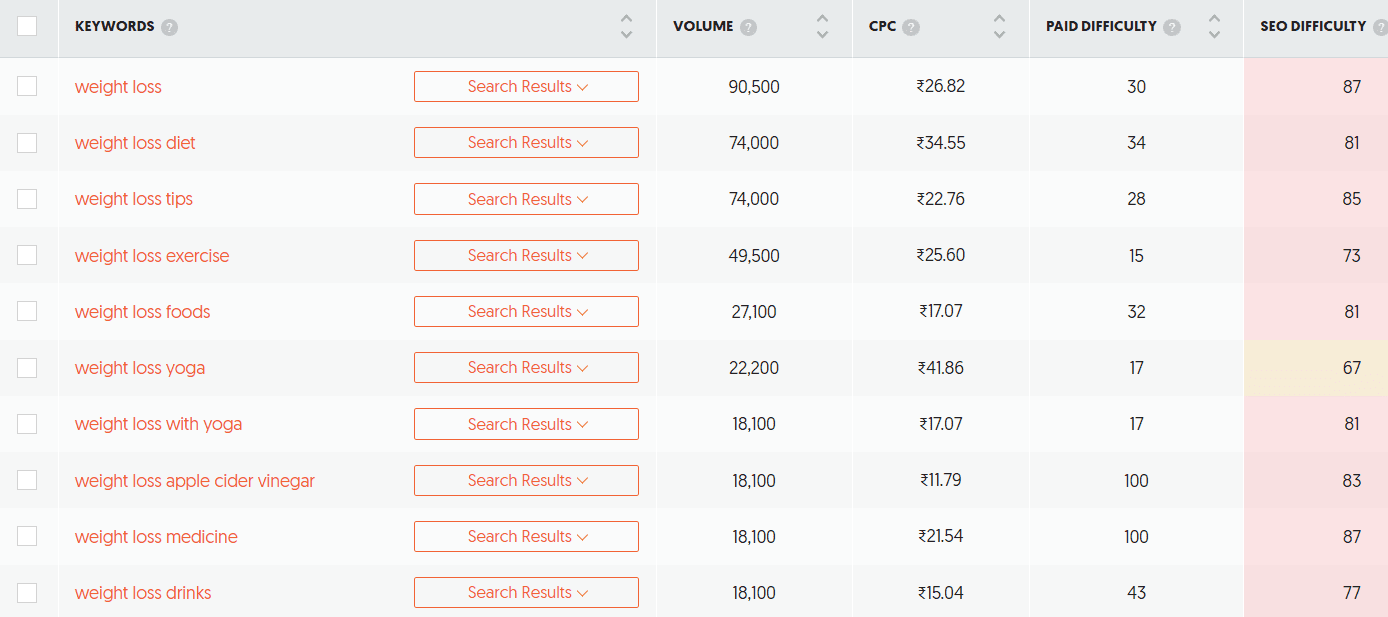
You can add these generated keywords to your keyword research list and sort them accordingly.
So these are five places where you can find different types of long-tail and short-tail keyword ideas.
And I also use them personally to find keyword ideas and I will list the keywords on a sheet and sort out the keywords as per requirement.
Also Read: How to do Keyword Research for SEO.
Conclusion
In this article, we went through the difference between short tail and long tail keywords, and saw examples of the long-tail and short-tail keywords.
And also showed you how to find keywords for your website or business in different ways.
Findings keywords are easy, but understanding the user intent behind those keywords is very important.
If your website is new, you always focus on Long tail keywords rather than short-tail keywords. Later, you can target short-tail keywords after getting some authority for your site.
Always focus on your target audience and try to understand their intent behind the keywords to produce quality content.
Google only ranks those sites on SERP, that are relevant and useful for Google users. Google users might turn into your users if you provide quality content and build trust.
I hope this article, gave you some insights, If you have any queries you can ask them in the comments. I like to read and reply.
Thank you.

1 thought on “Short Tail and Long Tail Keywords: Know the Exact Difference”